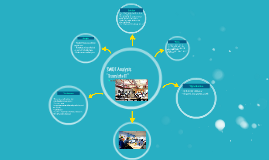Aesthetic SWOT Analysis Template
Transcript: Introduction to SWOT Analysis Examples of Common Threats SWOT Analysis is a strategic planning tool that helps organizations identify their Strengths, Weaknesses, Opportunities, and Threats. This analytical framework provides clarity on internal and external factors influencing business success. Common threats include economic instability, competitors launching new products, and shifts in consumer behavior. Businesses must stay informed about these factors to adapt their strategies and remain competitive. What is SWOT? Significance in Strategic Planning Mitigation Strategies for Threats SWOT stands for Strengths, Weaknesses, Opportunities, and Threats. It is a structured planning method used to evaluate these four elements, providing a clear overview of the internal and external environment affecting an organization. SWOT analysis plays a vital role in strategic planning by providing insights that inform strategy development. It helps leaders set priorities, allocate resources effectively, and anticipate potential challenges in the market. To address external threats, organizations can develop contingency plans, diversify offerings, and monitor market trends. Proactive risk management is vital for sustaining competitive advantages and ensuring business continuity. Why Conduct SWOT Analysis? Recognizing External Threats External threats arise from various factors including market competition, regulatory changes, and economic downturns. A comprehensive analysis of the operating environment can help identify these potential dangers before they impact the organization. The purpose of conducting a SWOT analysis is to align resources and capabilities with the competitive environment. It helps organizations uncover strategic advantages and areas needing improvement, guiding decision-making processes. Understanding Threats in SWOT Analysis External threats pose significant challenges to businesses, based on market conditions, competition, and other factors. Recognizing these threats is critical for effective strategic planning and risk management. Aesthetic SWOT Analysis Template Opportunities Identifying External Opportunities Opportunities in SWOT Analysis focus on external factors that can enhance an organization's success. Identifying these opportunities is vital for strategic growth and gaining competitive advantage. Create and Customize Your SWOT Analysis Effortlessly External opportunities can arise from market trends, technology advancements, or changes in consumer behavior. Regular analysis of the environment through tools such as PESTLE can help in identifying these factors early. Identifying Internal Strengths How to Capitalize on Opportunities To capitalize on opportunities, organizations should conduct SWOT analysis regularly, invest in market research, and remain agile. Adapting quickly to customer needs can convert potential opportunities into profitable ventures. Internal strengths are the positive attributes and resources an organization possesses, such as skilled personnel, solid financials, or innovative technologies. Assessing these factors provides insight into areas where the organization excels and can build upon for competitive advantage. Examples of Potential Opportunities Strengths Potential opportunities include new markets, emerging technologies, and partnerships. For instance, the rise of remote work presents opportunities for companies specializing in virtual collaboration tools. Examples of Common Strengths Understanding internal strengths is crucial for organizations to capitalize on their advantages and enhance overall performance. This section delves into how to identify and leverage these strengths effectively. Typical internal strengths include strong brand reputation, loyal customer base, efficient operational processes, and proprietary technology. Recognizing these strengths allows organizations to differentiate themselves from competitors and enhance market positioning. How to Leverage Strengths Organizations can leverage their strengths by integrating them into their strategic plans, enhancing marketing efforts, and pursuing growth opportunities. Utilizing internal strengths effectively creates a solid foundation for achieving business goals and objectives. Aesthetic Design Considerations Space Planning for Writing A visually appealing template uses balanced layout, harmonious color schemes, and clear typography. Incorporate icons or simple graphics to symbolize strengths, weaknesses, opportunities, and threats, making each section distinct yet cohesive. Ensure ample space for each section, allowing for detailed notes and insights. Divide areas effectively for each of the SWOT components, encouraging clear thought organization without overcrowding the template. Tips for Effective Use of the Template Understanding Internal Weaknesses The template should facilitate collaborative input and discussion. Use color-coding to prioritize items within each SWOT category, aiding quick

















